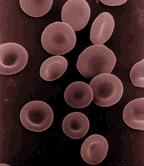
Red blood cell distribution width
Encyclopedia

Red blood cell
Red blood cells are the most common type of blood cell and the vertebrate organism's principal means of delivering oxygen to the body tissues via the blood flow through the circulatory system...
(RBC) width that is reported as part of a standard complete blood count
Complete blood count
A complete blood count , also known as full blood count or full blood exam or blood panel, is a test panel requested by a doctor or other medical professional that gives information about the cells in a patient's blood...
. Usually red blood cells are a standard size of about 6–8 μm. Certain disorders, however, cause a significant variation in cell size. Higher RDW values indicate greater variation in size. Normal reference range
Reference range
In health-related fields, a reference range or reference interval usually describes the variations of a measurement or value in healthy individuals...
in human red blood cells is 11–15%. If anemia
Anemia
Anemia is a decrease in number of red blood cells or less than the normal quantity of hemoglobin in the blood. However, it can include decreased oxygen-binding ability of each hemoglobin molecule due to deformity or lack in numerical development as in some other types of hemoglobin...
is observed, RDW test results are often used together with mean corpuscular volume
Mean corpuscular volume
The mean corpuscular volume, or "mean cell volume" , is a measure of the average red blood cell size that is reported as part of a standard complete blood count....
(MCV) results to determine the possible causes of the anemia. It is mainly used to differentiate an anemia of mixed causes from an anemia of a single cause. Vitamin B12
Vitamin B12
Vitamin B12, vitamin B12 or vitamin B-12, also called cobalamin, is a water-soluble vitamin with a key role in the normal functioning of the brain and nervous system, and for the formation of blood. It is one of the eight B vitamins...
deficiency produces a macrocytic anemia (large cell anemia) with a normal RDW. However, iron deficiency anemia initially presents with a varied size distribution of red blood cells, and as such shows an increased RDW. In the case of a mixed iron and B12 deficiency, there will normally be a mix of both large cells and small cells, causing the RDW to be elevated. An elevated RDW (red blood cells of unequal sizes) is known as anisocytosis
Anisocytosis
Anisocytosis is a medical term meaning that a patient's red blood cells are of unequal size. This is found in anemia and other blood conditions...
.
Calculations
The "width" in RDW is sometimes thought of as "misleading," since it in fact is a measure of deviation of the volume of RBCs, and not directly the diameter. However, "width" refers to the width of the volume curve (distribution width), not the width of the cells. Thus, it is a reasonably accurate term.Mathematically the RDW is calculated with the following formula:
- RDW = (Standard deviationStandard deviationStandard deviation is a widely used measure of variability or diversity used in statistics and probability theory. It shows how much variation or "dispersion" there is from the average...
of MCVMean corpuscular volumeThe mean corpuscular volume, or "mean cell volume" , is a measure of the average red blood cell size that is reported as part of a standard complete blood count....
÷ meanArithmetic meanIn mathematics and statistics, the arithmetic mean, often referred to as simply the mean or average when the context is clear, is a method to derive the central tendency of a sample space...
MCV) × 100.

